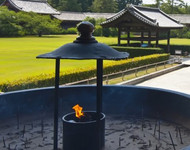The History of Japanese Incense
Posted by Rachel Newcombe
Incense has been used for centuries in sacred ceremonies and homes and it’s still very popular today. We take a look at the history and use of Japanese incense, which is one of the oldest and valued incense producing countries.
How Did Incense Arrive in Japan?
Incense is believed to have arrived in Japan when Buddhism and Buddhist monks first came to the country, from China. Incense was, and still is, an important part of Buddhism, as it’s used it ceremonies and rites to purify the atmosphere.
Incense has been used since Biblical times and it’s believed that it could have originally been created in Egypt. The Egyptian pharaohs are certainly known to have used incense and the Babylonians did too, when praying and reading oracles.
Over the years, Japan has adopted a wider use of incense and it’s now one of the most important world producers of incense.
When incense first came to Japan, it was made in China and imported, but as its popularity increased, specialist companies in Japan began to make their own. During the Feudal period in Japan, for example, incense was rolled into a stick to make it more affordable for poor people.
Many of the best Japanese incense companies, such as Baieido and Nippon Kodo, have been making incense for 300 years or more, using high quality, traditional ingredients and ancient and modern techniques.
Why Did Incense Become Popular in Japan?
Incense initially became popular in Japan because of its associations with Buddhism. The incense is used to purify the air, creating a more sacred space for performing religious rites and ceremonies.
But as people began to realise how fragrant incense was, and how the scent could create ambiance and sense of tranquillity in a room, it became more popular. In the 14th century, samurai warriors used to use incense to perfume their helmets and armour, with the belief that it would help produce an air of invincibility.
It was in the 15th and 16th centuries that incense began to become more popular with the middle and upper classes in Japan and a wider range of people began to use it in their lives.
As the appreciation of incense grew, increased numbers of individuals and groups took up practice of Koh-Do, to celebrate their Japanese incense making traditions and share their appreciation of the aromatic elements.
The Japanese Koh-Do Ceremony or Incense Appreciation
The Koh-Do, or Kodo, ceremony dates back to the Muromachi period (1336-1573) and is known as ‘the art of incense.’ In Japanese, the word ‘koh’ means ‘incense’.
Legend has it that Shogunate Yoshimasa Ashikaga requested that 130 varieties of aloeswood should be evaluated and Sanetaka Sanjonishi took up the task. Koh-Do, which is still celebrated today, involves the participants smelling the scents of various fragrant wood chips. They have to memorise the scent and later have to try and identify them.
Although it sounds rather game-like, there is an art of appreciation involved and of being able to appreciate the different aromas. The Japanese identified 10 Virtues of Koh, which describe the benefits that can be gained by using incense. These are:
1. It brings communication with the transcendent. 2. It purifies the mind and body. 3. It removes uncleanliness. 4. It keeps one alert. 5. It can be a companion in the midst of solitude. 6. In the midst of busy life, it brings a moment of peace. 7. When it is plentiful, one never tires of it. 8. When there is little, still one is satisfied. 9. Age does not change its efficacy. 10. Used everyday, it does no harm.
Koh-Do is still widely practiced in Japan, as well as in countries around the world, by fans of fine quality Japanese incense.
Japanese Incense Ingredients
Japanese incense is made up of high quality ingredients that are sourced from around the world.These include:
* Tabu – the bark of this tree, found in china, is often used to form of the shape of the incense. * Benzoin – this resin is made from the Styracacae tree that’s found in places such as Thailand, Vietnam and Indonesia and is used to help preserve the fragrance of incense. * Sandalwood – this has been used in Japanese incense for over 4,000 years and comes from trees in countries such as India, Indonesia and Australia. It helps give incense a sweet fragrance. * Nard – this is a herb found in countries such as India, China and Nepal and its root is used in incense, as it’s very aromatic. * Cassia – a popular ingredient in incense, this comes from countries such as Vietnam, Sri Lanka and Burma. * Camphol – this has good antiseptic benefits and can also be used to repel insects, so is good if you want to get insects out of your house. It comes from the evergreen leaves of the camphor tree, found in the rainforests in Malaysia and Borneo.
Types of Incense
There are three main types of incense – incense sticks, incense cones and incense coils. The type you choice will depend in part on the type of incense burner or holder you have, the room you’re burning it in and how long you’d like it to last. Incense sticks are usually long and quite thin and sticks are renowned for burns evenly and steadily, providing a mild fragrance. They’re best used with incense holders where the ash can fall down and be caught.
Incense cones provide a more intense fragrance than incense sticks, as they tend to burn faster than sticks. Due to this, they’re best used in larger spaces or bigger rooms, so the fragrance doesn’t become overpowering.
The third type of incense is incense coils. This form of incense is designed to burn for a much longer time (sometimes this can be for two hours at a time), so you’ll receive a steady fragrance over a longer period.
How to Use Incense
Using incense is very simple, but you do need an incense holder, plate or burner to stand it in and catch the ash. All you need to is light the tip of the incense stick, cone or coil, then blow out the flame. This produces a gentle wisp of smoke, which will release the aroma. The stick, cone or coil should then be placed in the incense holder or burner and left to fragrance your room. One stick, cone or coil can produce a fair amount of ash, so you will need to empty this out of the burner, or off the holder, after it’s finished.
How Incense Is Used Today
Incense is still used by many people around the world as part of their sacred ceremonies, by Buddhists and members of a wide range of faiths. Some Christian churches, for example, use incense for special services, or days when they’re celebrating saints. The scent is often distributed around the building by an incense shaker, so that all members of the congregation, whether at the front or the back, can catch the scent.
People who are meditating on their own often burn incense to purify the environment and help focus their mind and it’s used in all sorts of spiritual and healing contexts.
But it’s also widely used by people in their own home and even in offices, too. The various different types of incense, such as sticks and cones, are popular for adding a subtle aroma to the home or office, or it can be burnt to try and block out lingering cooking smells. One of the benefits of some of the Japanese incense, for example, is that they’ve perfected the art of not making it too smoky and therefore it’s more appealing to a wider range of people.
If you’ve never used incense, or haven’t yet had the chance to try any that’s originated from Japan, then it’s well worth giving this quality incense a try.
By Rachel Newcombe
© Holisticshop.co.uk. All rights reserved



